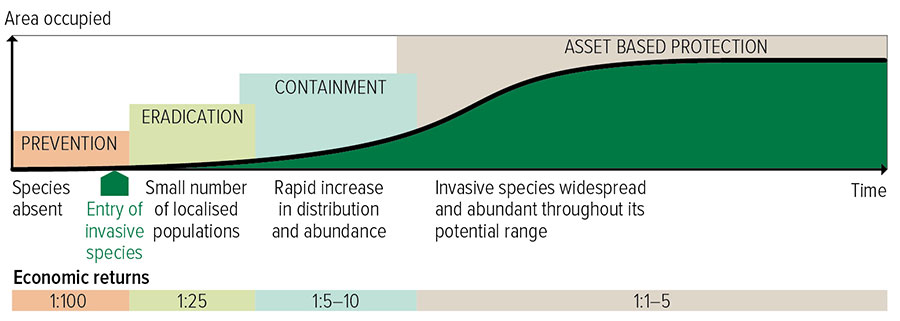Early detection and prevention are key components of a biosecurity plan that is designed to reduce the likelihood and impact of devastating pests, diseases and weeds entering farms.
In 2010, the then Victorian Department of Primary Industries (now Agriculture Victoria) published the Invasive Plants and Animals Policy Framework (IPAPF). The framework identifies the four key aspects of the Victorian Government’s overall approach to managing the different stages of an invasive species. These are:
- prevention – keeping new pests out;
- eradication – targeting high-risk pests for eradication;
- containment – preventing an initial infestation from spreading further; and
- asset-based protection – management to minimise impacts on assets and production.
The department developed a ‘generalised invasion curve’ that demonstrates how money spent in prevention is significantly more cost-effective than eradication, containment or asset-based protection.

Figure 1: Generalised pest invasion curve. Source: Agriculture Victoria
From a financial perspective, it is a no-brainer to incorporate early detection and prevention strategies into farm biosecurity practices to prevent a pest or disease incursion from happening in the first place.
“It is more efficient and economical to invest in preventative farm biosecurity measures than it is to mitigate risks after an incursion,” says Stuart Kearns, the national manager of preparedness and research, development and extension at Plant Health Australia. He says prevention applies to species not yet present in Australia or not yet present in a region or on a farm.
“Prevention is one of the key components of a good farm biosecurity plan and requires the coordination of various activities,” Mr Kearns says.
These activities include identifying high-risk pests, diseases and weeds and the likely pathways they could use to enter Australia, a region or a farm. At farm level, the purchase and delivery of inputs such as seed, fertiliser, feed and forage can pose a risk and all inputs should come from a reputable source and be weed and disease-free . Movement of people, vehicles and equipment is another common pathway for pests to enter a property.
The risk associated with these pathways can be minimised by applying good hygiene and focusing on ‘come clean, go clean’ principles. Best practice includes use of an on-farm clean-down facility to inspect and clean down vehicles, machinery and personal equipment before entering the farm.
Other risk mitigation strategies involve keeping vehicles, other than those belonging to the property, out of cropping areas.
Unfortunately, not all risks can be controlled through good hygiene. Some, such as wind, wild animals and floodwater, are unavoidable.
The first step is to recognise these alternative pathways as a risk, and then to identify mitigating strategies. Although these risks are not controllable, there are practical measures to minimise the impact. For example, if there is a floodway through the property, part of the biosecurity plan would include surveillance after flood events.
The aim of the prevention phase is to not let new pests or diseases go unmanaged and become established.
State | Grains biosecurity | Phone | |
|---|---|---|---|
New South Wales | Bill Gordon | 0428 133 944 | |
Queensland | Kym McIntyre | 0429 727 690 | |
South Australia | Vacant | ||
Victoria | Jim Moran | 0418 377 930 | |
Western Australia | Jeff Russell | 0447 851 801 |
Table 1: State grains biosecurity officers.
Pathway risk mitigation strategies include keeping visitor logs that should ideally include name, contact number, date of entry and reason for the visit.
Another key step is hanging a biosecurity sign at the front gate that clearly states that the property has a biosecurity plan and what is expected of visitors. New or replacement biosecurity gate signs are available free from the grains biosecurity officer in your region and supplied through grain grower levies.
Remember, just like the Victorian Government uses early detection and prevention principles when defining its state-wide biosecurity framework, growers can apply the same principles to keeping pests, diseases and weeds off the farm in an efficient and cost-effective manner.
If you spot anything unusual or find something you are not sure about, call the Exotic Plant Pest Hotline on 1800 084 881.
More information: FarmBiosecurity; FarmBiosecurity e-newsletter

























































